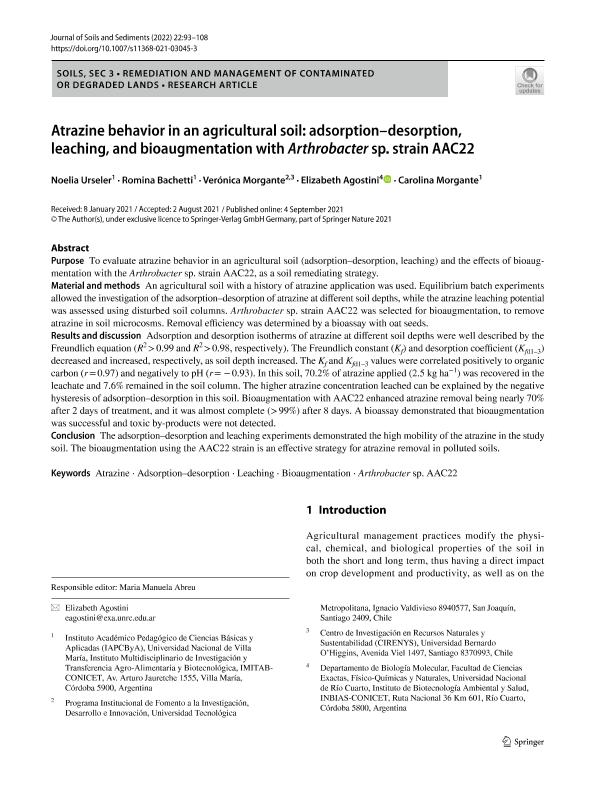Artículo
Atrazine behavior in an agricultural soil: adsorption–desorption, leaching, and bioaugmentation with Arthrobacter sp. strain AAC22
Urseler, Noelia Luján ; Bachetti, Romina
; Bachetti, Romina ; Morgante, Verónica; Agostini, Elizabeth
; Morgante, Verónica; Agostini, Elizabeth ; Morgante, Carolina
; Morgante, Carolina
 ; Bachetti, Romina
; Bachetti, Romina ; Morgante, Verónica; Agostini, Elizabeth
; Morgante, Verónica; Agostini, Elizabeth ; Morgante, Carolina
; Morgante, Carolina
Fecha de publicación:
01/2022
Editorial:
Springer Heidelberg
Revista:
Journal of Soils and Sediments
ISSN:
1439-0108
e-ISSN:
1614-7480
Idioma:
Inglés
Tipo de recurso:
Artículo publicado
Clasificación temática:
Resumen
Purpose: To evaluate atrazine behavior in an agricultural soil (adsorption–desorption, leaching) and the effects of bioaugmentation with the Arthrobacter sp. strain AAC22, as a soil remediating strategy. Material and methods: An agricultural soil with a history of atrazine application was used. Equilibrium batch experiments allowed the investigation of the adsorption–desorption of atrazine at different soil depths, while the atrazine leaching potential was assessed using disturbed soil columns. Arthrobacter sp. strain AAC22 was selected for bioaugmentation, to remove atrazine in soil microcosms. Removal efficiency was determined by a bioassay with oat seeds. Results and discussion: Adsorption and desorption isotherms of atrazine at different soil depths were well described by the Freundlich equation (R2 > 0.99 and R2 > 0.98, respectively). The Freundlich constant (Kf) and desorption coefficient (Kfd1–3) decreased and increased, respectively, as soil depth increased. The Kf and Kfd1–3 values were correlated positively to organic carbon (r = 0.97) and negatively to pH (r = − 0.93). In this soil, 70.2% of atrazine applied (2.5 kg ha−1) was recovered in the leachate and 7.6% remained in the soil column. The higher atrazine concentration leached can be explained by the negative hysteresis of adsorption–desorption in this soil. Bioaugmentation with AAC22 enhanced atrazine removal being nearly 70% after 2 days of treatment, and it was almost complete (> 99%) after 8 days. A bioassay demonstrated that bioaugmentation was successful and toxic by-products were not detected. Conclusion: The adsorption–desorption and leaching experiments demonstrated the high mobility of the atrazine in the study soil. The bioaugmentation using the AAC22 strain is an effective strategy for atrazine removal in polluted soils.
Archivos asociados
Licencia
Identificadores
Colecciones
Articulos(CCT - CORDOBA)
Articulos de CTRO.CIENTIFICO TECNOL.CONICET - CORDOBA
Articulos de CTRO.CIENTIFICO TECNOL.CONICET - CORDOBA
Citación
Urseler, Noelia Luján; Bachetti, Romina; Morgante, Verónica; Agostini, Elizabeth; Morgante, Carolina; Atrazine behavior in an agricultural soil: adsorption–desorption, leaching, and bioaugmentation with Arthrobacter sp. strain AAC22; Springer Heidelberg; Journal of Soils and Sediments; 22; 1-2022; 93-108
Compartir
Altmétricas



